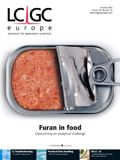ISRANALYTICA 2008
Isranalytica 2008 - The 11th Annual Conference of the Israel Analytical Chemistry Society, Tel Aviv, Israel
January 2008
ISRANALYTICA 2008 — The 11th Annual Conference of the Israel Analytical Chemistry Society, Tel Aviv, Israel
Organised by the Israel Analytical Chemistry Society, the conference takes place from 22–23 January 2008, at the David Intercontinental Hotel, Tel Aviv.
The programme will cover an assortment of topics in Analytical Chemistry, including: separation methods (CE, LC, GC and others), mass spectrometry, nano analytical chemistry, analytical methods, bio-analytical methods, analytical spectroscopy, proteomics, genomics and metabolomics; water analytical chemistry, analytical chemistry in homeland security, forensic analytical chemistry, analytical electrochemistry, analytical sensors, chemometry and computerized analytical chemistry.
Among the speakers will be Professor R. Graham Cooks, Department of Chemistry, Purdue University, West Lafayette, Indiana, USA, with Towards the Personal Mass Spectrometer: Chemical Analysis in Situ and in Real Time and Professor Reinhard Niessner, Institute for Hydrochemistry and Chair for Analytical Chemistry Technical University of Munich, Germany, with Laser Light or Antibody — Two Good Friends to Analysts.
For more information contact Dorit Eldar, BioForum Applied Knowledge Centre, Golda Meir 7, POB 4034, Ness Zionna, 70400, Israel, tel: +972 8 9313070,
fax: +972 8 9313071,
e-mail: dorit@bioforum.org.il
or visit http://www.isranalytica.org.il
New TRC Facility Accelerates Innovation and Delivery
April 25th 2025We’ve expanded our capabilities with a state-of-the-art, 200,000 sq ft TRC facility in Toronto, completed in 2024 and staffed by over 100 PhD- and MSc-level scientists. This investment enables the development of more innovative compounds, a broader catalogue and custom offering, and streamlined operations for faster delivery. • Our extensive range of over 100,000 high-quality research chemicals—including APIs, metabolites, and impurities in both native and stable isotope-labelled forms—provides essential tools for uncovering molecular disease mechanisms and exploring new opportunities for therapeutic intervention.
New Guide: Characterising Impurity Standards – What Defines “Good Enough?”
April 25th 2025Impurity reference standards (IRSs) are essential for accurately identifying and quantifying impurities in pharmaceutical development and manufacturing. Yet, with limited regulatory guidance on how much characterisation is truly required for different applications, selecting the right standard can be challenging. To help, LGC has developed a new interactive multimedia guide, packed with expert insights to support your decision-making and give you greater confidence when choosing the right IRS for your specific needs.

.png&w=3840&q=75)

.png&w=3840&q=75)



.png&w=3840&q=75)



.png&w=3840&q=75)











